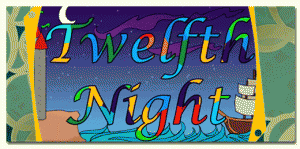What is 12th Night?
 From Wikipedia: “Twelfth Night is a festival, in some branches of Christianity marking the coming of the Epiphany. There is disagreement as to whether the Twelfth Night falls on 6th January or the 5th; the Church of England insists that it is on the 5th and “refers to the night before Epiphany, the day when the nativity story tells us that the three wise men visited the infant Jesus. In pagan days, 12 night originally came from the 12 days of Yuletide which began at sunset on December 20, known as Mother Night, and ended on the night of December 31, the Night of the Oak King and the Roman day of Hecate
From Wikipedia: “Twelfth Night is a festival, in some branches of Christianity marking the coming of the Epiphany. There is disagreement as to whether the Twelfth Night falls on 6th January or the 5th; the Church of England insists that it is on the 5th and “refers to the night before Epiphany, the day when the nativity story tells us that the three wise men visited the infant Jesus. In pagan days, 12 night originally came from the 12 days of Yuletide which began at sunset on December 20, known as Mother Night, and ended on the night of December 31, the Night of the Oak King and the Roman day of Hecate
Food and drink are the center of the celebrations in modern times, and all of the most traditional ones go back many centuries. The punch called wassail is consumed especially on Twelfth Night, but throughout Christmas time, especially in the UK.
Around the world, special pastries, such as the tortell and king cake are baked on Twelfth Night, and eaten the following day for the Feast of the Epiphany celebrations.
In English and French custom, the Twelfth-cake was baked to contain a bean and a pea, so that those who received the slices containing them should be designated king and queen of the night’s festivities.
In Ireland it is still the tradition to place the statues of the Three Kings in the crib on Twelfth Night or, at the latest, the following Day Little Christmas.
 In colonial America, a Christmas wreath was always left up on the front door of each home, and when taken down at the end of the Twelve Days of Christmas, any edible portions would be consumed with the other foods of the feast. The same held true in the 19th-20th centuries with fruits adorning Christmas trees.
In colonial America, a Christmas wreath was always left up on the front door of each home, and when taken down at the end of the Twelve Days of Christmas, any edible portions would be consumed with the other foods of the feast. The same held true in the 19th-20th centuries with fruits adorning Christmas trees.
Fresh fruits were hard to come by, and were therefore considered fine and proper gifts and decorations for the tree, wreaths, and home. Again, the tree would be taken down on Twelfth Night, and such fruits, along with nuts and other local produce used, would then be consumed.
In the eastern Alps, a tradition called Perchtenlaufen exists. Two to three hundred masked young men rush about the streets with whips and bells driving out evil spirits. In Nuremberg until 1616, children frightened spirits away by running through the streets and knocking loudly at doors.
In some countries, the Twelfth Night and Epiphany mark the start of the Carnival season, which lasts through Mardi Gras Day. Modern American Carnival traditions shine most brightly in New Orleans, where friends gather for weekly King Cake parties. Whoever gets the slice with the “king”, usually in the form of a miniature baby doll (symbolic of the Christ Child, “Christ the King”), hosts next week’s party.
 In parts of Kent, there is a tradition that an edible decoration would be the last part of Christmas to be removed in the Twelfth Night and shared amongst the family.
In parts of Kent, there is a tradition that an edible decoration would be the last part of Christmas to be removed in the Twelfth Night and shared amongst the family.
Drury Lane Theatre in London has had a tradition since 1795 of providing a Twelfth Night cake. The will of Robert Baddeley made a bequest of £100 to provide cake and punch every year for the company in residence at the theatre on 6 January. The tradition still continues.
Of course, Twelfth Night is also one of Shakespeare’s comedies, where a shipwrecked Viola pretends to be a man, and much farcical comedy ensues.
You must be logged in to post a comment.